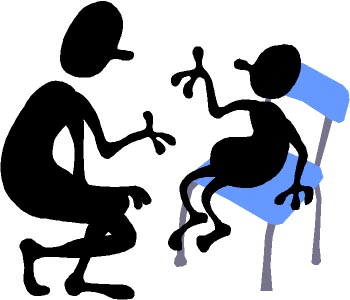

When we see misbehavior in the classroom, it is oftentimes necessary to call the student aside to discuss his/her inappropriate actions. While other counseling techniques provide specific types of responses or a general focus, classroom conferencing (McIntyre, 1985) is different in that it offers an outline or format for conducting a "long talk" with the student. These procedural guidelines provide structure to the counseling situation while allowing you to use the interaction or counseling style with which you are most comfortable.
This flexibility is important due to our differing personalities and philosophies which make some of us more directive, reflective, reserved, understanding, non directive, collegial, or authoritarian than others. Classroom conferencing provides a series of steps to assist you in directing behavioral changes in misbehaving students. This approach actively involves the pupil in the change of personal interaction behavior, thus giving him/her a "stake" in the behavior change program. Over time, by reasoning with the student, one can promote inner control of behavior and effect more permanent changes.
How to Use Classroom Conferencing
1. Meet with the student as soon as possible after the incident. Arrange for a minimum of distractions by meeting in private or inform other students that they are not to interrupt. Assure that your conference cannot be overheard by others.
2.![]() Ask the
student to review what happened (Use a respectful and concerned voice).
Listen closely (truly LISTEN
Ask the
student to review what happened (Use a respectful and concerned voice).
Listen closely (truly LISTEN  )
to the youngster. Hear his/her viewpoint...Remember, there are two
sides to every pancake. Immediately (and respectfully) correct
any misconceptions, differences of opinion, or lies so that both of you
are dealing with the same perceptions of the situation.
)
to the youngster. Hear his/her viewpoint...Remember, there are two
sides to every pancake. Immediately (and respectfully) correct
any misconceptions, differences of opinion, or lies so that both of you
are dealing with the same perceptions of the situation.
3. Discuss morality and common courtesy, and question the student as to what was right and wrong in that given situation. Discuss whose rights or privileges were violated and by whom.
4. Discuss the student's pattern of behavior (Each student with behavioral or emotional issues tends to have his/her own stereotypic reaction to frustration). Let the student know that his/her idiosyncratic behavior is unacceptable in the classroom/school/playground and cannot be tolerated.
5. Agree on a new reaction pattern. Have the student suggest other possible ways of handling the situation should it occur again. Ask the student to list as many alternative reactions as possible, even if s/he disagrees with their use. Write these possible solutions on paper. Ask the student to identify one that s/he will use in the future. Discuss the pros and cons of that decision. Choose another if that one is not acceptable.
6. Expect "back sliding".  Reconvene your conference as necessary to review the student's progress.
Expect change to take time and perhaps many conferences. Never give
up on the student. Recognize any improvement or effort.
Reconvene your conference as necessary to review the student's progress.
Expect change to take time and perhaps many conferences. Never give
up on the student. Recognize any improvement or effort.
.
Another System to Consider
"PROBLEM SOLVING"
(use separately or blend with classroom conferencing)
1. Identify and define the problem or situation. Do so by asking the student(s) the following question: "What problems are we having?" Work on avoiding blame. Focus on actions and reactions. Work on objectivity in describing the problem.
2. Generate alternatives for solving the problem. Say: "What can we do to help you (and others) to display appropriate behavior?"
3. Evaluate the alternative suggestions with the suggestion. Ask the student to elaborate by asking "What do you think of this suggestion?" Go over pros and cons of each alternative.
4. Implement the decision agreed upon.
5. Conduct a follow up evaluation. Ask "How effective was
this decision?" Adjust the plan as necessary.
1. With others, discuss the importance of steps one, two and three of the classroom conferencing.
2. How many classroom conferences do you conduct and how long do you wait for behavior to change before you give up and decide upon another intervention?
3. What do you do if the student fails to cooperate during the conference?
4. Fran reacts to teasing by others by hitting them.
The following is a listing of alternative solutions given by Fran for handling
the teasing:
a. kick them
b. spit at them
c. give them "the finger" while cursing at them
d. call the teacher
e. call them names in return
f. ignore the teasing
When asked which s/he will use in the future, Fran sees them as being in
order of his/her preference. What are the concerns you have
with each? At which point will you say, "OK. This one
sound good."?
5. What other solutions might you recommend for Fran's consideration? (See #4 above)
6. With a partner who plays the part of the student, practice classroom conferencing. Use a real life situation, or one of the following situations:
a. During a softball game, a ground ball gets by Nick and rolls toward the far end of the playground. Nick chases after it, and runs through an area where other students are playing with marbles. After throwing the ball too late to tag the runner at home plate, Nick, in anger, blames the marble players for slowing him down. He kicks a pile of marbles and throws a few over a distant fence. You call Nick over to you. He approaches you, but is still contaged by his angry feelings.
b. Penny leaves her seat to throw away a wad of paper. Because you are teaching a lesson, you tell her to sit down. After a short argument and a repeating of your direction, she reluctantly returns to her desk while mumbling. A few minutes later, Nancy arises again and despite your command for her to return to her seat, she throws away the paper before doing so. In your conference you find that she asked the teacher aide/para-professional if she could throw away the paper after you told her "No". The aide said "Yes". (Will you also talk to the aide?)
c. Two boys make faces, groan, and say rude remarks when a rather plump girl enters the room or is called upon during a lesson. She often becomes angry and belligerent because of the boy's actions.
![]()
| Fetch Dr. Mac's Home Page |